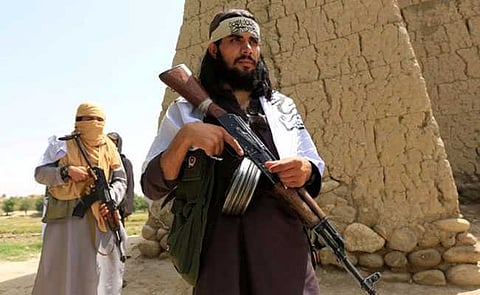As Taliban Wrests Power In Afghanistan, The US Has A Lot Of Explaining To Do
It is on record that officials of the George Bush administration had lied to the Senate Armed Forces Committee about Saddam Hussein developing nuclear weapons/Weapons of Mass Destruction to facilitate the US invasion of Iraq in March 2003.
But the reasons for the invasion were many: furthering the US policy of regime change in multiple countries including Iraq, Syria besides others; strategic gains in controlling energy reserves in the region, oil pipelines and the Persian Gulf; countering Chinese and Russian influence, and boosting the American arms industry by way of weapon sales through instability and conflict.
After the invasion, it became more than clear that Saddam Hussein had no nuclear program going. But the American public did not mind because the arms industry was benefiting from the weapon exports, supplying to nations engaged in the conflict in Iraq and Syria. In addition, leading the 40-nation coalition against ISIS/ISIL boosted the image of the US as a superpower. It did not matter that the rise of ISIS/ISIL was the “willful decision” of the US as disclosed publicly by Michael Flynn, National Security Advisor of the US.
Invasion of Afghanistan
For the US invasion of Afghanistan in 2001, no excuses were required because of the 9/11 terrorist attacks by Al Qaeda. The stated aim was to finish off Al Qaeda and kill Osama bin-Laden but, according to a Carnegie Endowment delegation that visited India in the immediate aftermath of the invasion, the US was also conscious of the large energy reserves in Central Asia, besides wanting to counter Russian and Chinese influence in the region.
Osama bin Laden was eventually traced to a compound in Abbottabad in Pakistan and killed in a raid by America’s Seal Team Six in 2011. Nine years later in February 2020, the US shook hands with the Taliban it had fought since 2001 and signed a peace deal. It was obvious that the US had decided to barter the safety of its own troops while pulling them out in exchange for consigning Afghanistan to Taliban rule.
The US sent 3,000 troops to guard Kabul airport and help evacuate its embassy staff, American nationals and associates. The British are sending 600 troops and Canada its Special Forces to evacuate their nationals. But the Pentagon spokesperson John Kirby went on telling reporters that there was no imminent danger to Kabul.
There is no way the US did not know the capabilities and intentions of the Taliban with the CIA having established them in the first place to oust the Soviets from Afghanistan. Now the American public is being told that the US has completed its task in Afghanistan – that the Al Qaeda is practically finished and the Taliban have promised they will not have any links with the Al Qaeda and not let the territory of Afghanistan be used against America and American interests.
But nothing can be farther from the truth. The UN Assistance Mission in Afghanistan (UNAMA) confirms that Al Qaeda’s links with the Afghan Taliban are as strong as ever. The Pakistan army and its proxies continue to support and fight alongside the Afghan Taliban.
US needs to explain
The US administration needs to explain to the American public and its NATO allies what has been achieved in two decades of occupation of Afghanistan and what about the over 3,500 coalition troops killed and over 20,300 servicemen wounded in action in addition to other US civilian casualties in Afghanistan? Can the US deny that after paying this price in human lives and expenditure of some USD 3 trillion, why has the Taliban been allowed to turn the clock back to its rule before the US invasion?
The Taliban blitzkrieg left the government forces almost dumbfounded, who melted away in a matter of weeks, leaving the world shocked. As of Sunday, the hard-line Sunni Islamist militia has encircled capital Kabul, after establishing effective control over almost 30 of its total 34 provinces, and is reportedly seeking the unconditional surrender of the Afghan government. Afghan President Ashraf Ghani and National Security Adviser Hamidullah Mohib have fled the country this evening, multiple reports say.
After staging the 20 years-long insurgency against thE US-backed Afghan government, the Sunni Islamist group is all set to take power in the country, as the intense months-long military offensive wiped out most of the Afghan forces. There is panic in Afghanistan as well as in the West. Afghans by thousands were making a beeline for Kabul every day before Sunday. Kabul is now a massive refugee camp sans water, food and sanitation.
The US sent 3,000 troops to guard Kabul airport and help evacuate its embassy staff, American nationals and associates. The British are sending 600 troops and Canada its Special Forces to evacuate their nationals. But the Pentagon spokesperson John Kirby went on telling reporters that there was no imminent danger to Kabul.
The thousands of Afghans killed and millions displaced in the US War on Terror without making Pakistan pay for its double game would be of little concern to the US administration. But the American public deserves an explanation: what did the US achieve in 20 years of stay in Afghanistan?
Is all the talk of counter-terrorism a bluff after leaving Afghanistan at the mercy of the Taliban? Can the US pose as the champion of human rights after abandoning the Afghan population to this horrendous human tragedy?
(The writer is an Indian Army veteran. The views expressed are personal. Published by special arrangement with South Asia Monitor)

